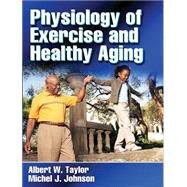Physiology of Exercise and Healthy Aging
, by Taylor, Albert- ISBN: 9780736058384 | 0736058389
- Cover: Hardcover
- Copyright: 10/25/2007
As life expectancy continues to increase, so does the need to understand the factors that increase health and vitality. Physiology of Exercise and Healthy Agingapplies the science of exercise physiology to an analysis of the aging process and identifies the positive effects that regular exercise and physical activity have not only on longevity but also on delaying specific diseases, decreasing morbidity, and increasing quality of life. It presents theories on aging, the aging process, the structural and functional changes that characterize advancing age, exercise programming concerns for the aged, drug use and abuse by seniors, and the benefits of exercise and physical activity.This text offers a more expansive discussion of the particulars of exercise physiology of aging persons than is found in other texts on the subject. With Physiology of Exercise and Healthy Aging, readers will gain a thorough understanding of the role of physical activity on the aging process, the principles of exercise and assessment considerations for elderly adults, and training for special needs of older adults. Information is presented in the context of three groups found in the aging and health spectrum: average aging individuals, frail elderly, and master athletes. This information is organized within a three-part structure:-Part Iexplores age-related changes in the major physiological systems. The effects of physical activity on these systems, as well as necessary adaptations for those with impaired abilities in each system, are also discussed.-Part IIdeals with the interactive roles of nutrition; age-related diseases, such as diabetes and osteoporosis; and physical activity.-Part IIIpresents the physiologic adaptability that may be expected with training and physical activity of older adults. It also addresses the practical issues that must be considered when working with this population, including training for aerobic, anerobic, and muscular fitness; exercise adherence and safety measures; and potential substance abuse of commonly used medications. In addition to the presentation of foundational concepts of physiology as they relate to the process of aging, chapters ofPhysiology of Exercise and Healthy Agingcontain exercise regimens related to the chapter topic, other forms of physical activity that have proven beneficial to the aging population, and contraindicated exercises. Physiological responses to acute and chronic exercise perturbations are examined, including studies of cardiorespiratory fitness, muscle metabolism and strength, neurophysiology and the senses, and the effects of exercise on older adults with the diseases of aging, including type 2 diabetes, osteoporosis, arthritis, and cardiovascular disease. Chapter-opening quotes provide the insights of selected thinkers, scientists, and fitness professionals on the topic discussed.Practitioners who work with older adults will find programming recommendations in each chapter to help translate the science into practice. An appendix offers easy access to forms and assessments, including a Three-Day Nutritional Assessment form and a Client History form. The language used throughout the text embraces the science of exercise physiology but also welcomes practitioners to apply the information presented.For student readers, Physiology of Exercise and Healthy Agingincorporates these helpful features to assist learning and retention:-Chapter-opening outlines offer quick reference to topics.-Chapter-ending Questions to Consider provide tools for self-study and reflection.-Numerous tables and figures reinforce chapter concepts and add visual or statistical information related to the process of aging, fall prevention, international demo







